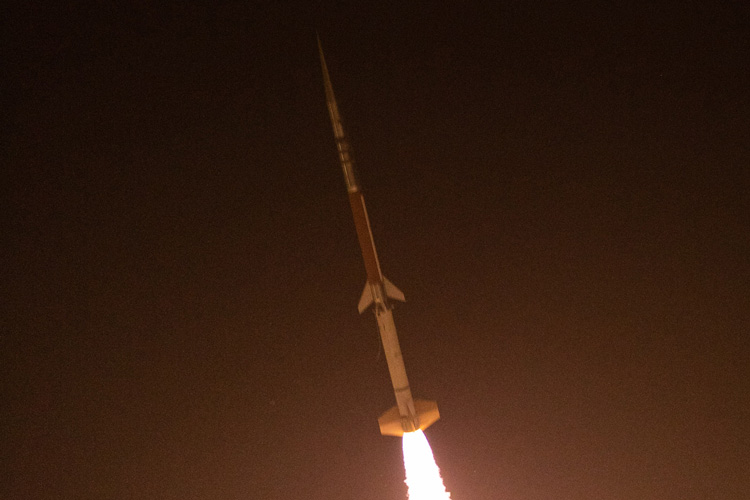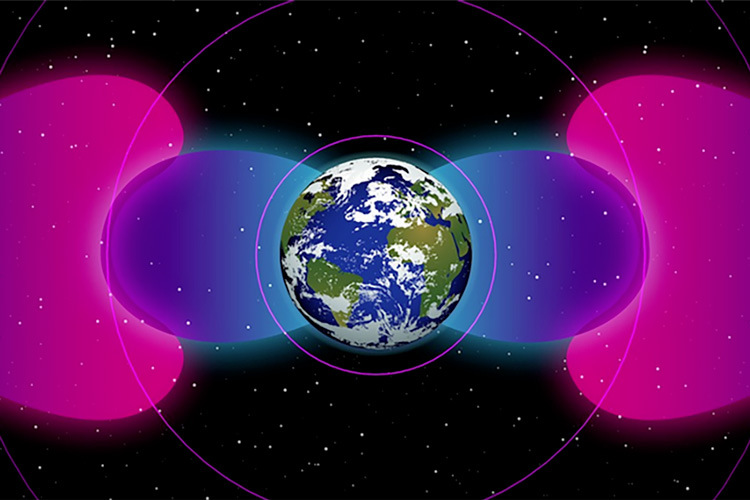Do lightning storms affect high-flying satellites?
Space scientists launched a sounding rocket through the ionosphere to explore the effects of leakage of very low frequency waves generated by lightning
May 27, 2021

The VIPER experiment was aboard this sounding rocket when it was launched at 9:15 p.m. EDT on Wednesday, May 26, 2021, from Wallops Flight Facility in Virginia. (Photo courtesy of NASA)
Lightning storms produce bursts of radio waves called whistlers that seem innocuous as they bounce off the ionosphere and dissipate with seemingly little effect.
But at night, the ionosphere becomes more transparent to these very low frequency (VLF) radio waves, and some travel out to the radiation belts around Earth where GPS and geosynchronous satellites sit.
A rocket experiment designed and led by University of California, Berkeley, scientists pierced the ionosphere last night (May 26) to measure how much of these VLF waves escape, in an attempt to assess whether VLF waves affect the Van Allen radiation belts through which the satellites travel, or even whether the VLF may protect the satellites from damage by high-energy electrons in the belts.
“It was an incredible experience watching this flight for me,” said John Bonnell, a physicist at UC Berkeley’s Space Sciences Laboratory who led The VLF trans-Ionospheric Propagation Experiment Rocket, or VIPER.
All went well, he said. VIPER was launched at 9:15 p.m. EDT from NASA’s Wallops Flight Facility aboard a Terrier-Improved Malemute suborbital sounding rocket. The launch had been postponed from May of 2020 because of the COVID-19 pandemic. The rocket with its 620-pound payload rose to about 94 miles before descending and splashing into the Atlantic Ocean. The payload was not recovered.
He and his team are now beginning to check the data.

Very low frequency waves (blue lobes) escaping through the ionosphere at night may be holding back the ionizing radiation – potentially damaging high-energy electrons – in the Van Allen radiation belts (pink). The VIPER experiment led by UC Berkeley is trying to find out.
“The VLF waves don’t cause problems with the current generation of spacecraft and satellites,” said Bonnell, principal investigator of the VIPER project. “In fact, those waves can reduce the hazard posed by the Van Allen radiation belts to those spacecraft and satellites by scattering the energetic particles and dumping them out of the belt and into the upper atmosphere where they dissipate safely.”
VIPER will provide data that can be compared with existing numerical models of the fields and the ionosphere, as well as observations made in the past of the escaping VLF radiation at higher altitudes and on the ground, to better understand the impact of escaping nighttime radio waves on the radiation belts.
“While we don’t fly high enough to get to the Van Allen radiation belt itself, we do fly high enough to see the details of how the VLF waves are absorbed, reflected and transmitted by the ionosphere, and to measure how much of the wave power escapes,” he said. “It was surprising to find that, while lots of ground-based and orbital observations of the VLF absorption, reflections and transmission had been made, there’s not been any measurements right in the region where all the action happens. While we have good models of what to expect in such regions, actual measurements are key to pin down the details of those models, as well as to develop the instruments required to explore more challenging regions.”
Ionosphere and beyond
Scientists at SSL have been studying the ionosphere for decades, and currently operate a satellite, ICON, that explore the link between thunderstorms and plasma waves in the ionosphere, a region named for the ionized particles created by sunlight.

The nighttime launch from NASA’s Wallops Flight Facility was scheduled for a time when the ionosphere becomes more transparent to VLF waves. That evening’s rare blood moon can be seen at lower left. (Photo courtesy of NASA)
VIPER traveled above the ionosphere to investigate the region between the ionosphere and space. While the ionosphere is about 60 miles above our heads, the two Van Allen radiation belts are much farther out, and contain charged particles from the sun that have been trapped by our magnetic field.
“Those belts of intense energetic electron fluxes cover a range of distances from Earth, from as close as 14,300 miles altitude — which is about 4.4 Earth radii — out to 23,500 miles altitude — about 7 Earth radii,” Bonnell said. “GPS satellites orbit at around 4.4 Earth radii, and geosynchronous satellites at about 6.6 Earth radii. So, satellites in those orbits are often engulfed by the Van Allen Radiation Belts and have to tolerate the effects those energetic particles have on electronics and materials.”
There is evidence that when VLF waves interact with the charged particles in the radiation belts, they can drain the belts after magnetic storms or sub-storms have filled them up. The leaking VLF may thus be an “impenetrable barrier” for high-energy electrons, protecting spacecraft in that region.
Lightning isn’t the only source of VLF waves, Bonnell noted. While most human communication — AM and FM radio, cellphone, Wifi and Bluetooth — takes place at higher frequencies, VLF has one advantage: it can penetrate tens of meters below the surface of the ocean. It has been used by the U.S Navy and other organizations for decades to communicate with submarines.
In addition to the in-situ measurements made by VIPER as it flew through the ionosphere, the mission also employed numerous ground-based systems, including some in Maine, North Carolina, Georgia, Colorado and Virginia. Bonnell’s collaborators are at the Goddard Spaceflight Center in Maryland, University of Colorado, University of Iowa and UCLA.